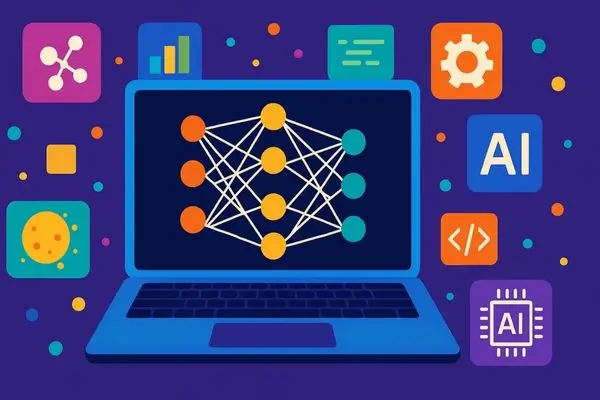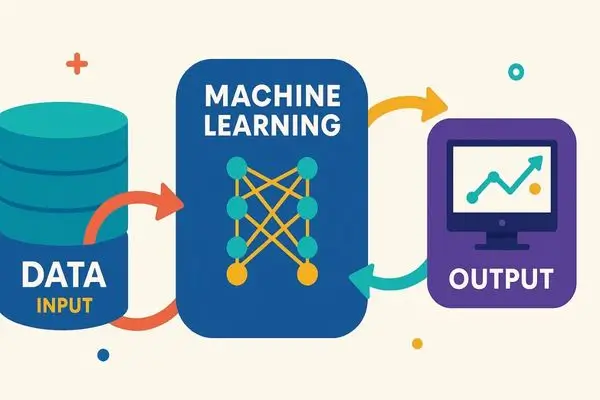Is Machine Learning Hard? Let’s understand, have you ever wondered if machine learning is as tough as it sounds? The buzz around artificial intelligence (AI) and machine learning (ML) can make it seem like a field only for tech wizards with advanced degrees. But here’s the good news: it’s not as complicated as you might think! By choosing the right tools and a strong mindset, anyone can start exploring this exciting world of AI and Machine Learning.
hstech.io breaks down why machine learning feels intimidating, debunks common myths, and shares practical ways to get started. Whether you’re a curious beginner or looking to boost your career practically, we’ve got you covered with simple steps, free resources, and real-world inspiration.
See Also: AI vs ML in 2025? Comparison and Inspiring Guide for Beginners
Main Topics
Table of Contents
1. Let’s Understand Machine Learning
1.1 What actually is Machine Learning?
Machine learning is an integral part of AI where computers learn from data to make decisions or predictions without being explicitly programmed. Think of it as teaching a computer to think a bit like a human by learning from examples.
For instance, when Netflix suggests a movie you’ll love, that’s machine learning analysing your viewing habits. Or when your email flags spam, it’s ML spotting patterns in messages. These everyday examples show how ML is already part of our lives.

1.2 Why People Think It’s Hard
Machine learning can seem scary for a few reasons:
- Math Overload: Terms like calculus, linear algebra, and statistics sound complex.
- Coding Challenges: Many assume you need to be a pro at programming languages like Python or R.
- Data Complexity: Working with large datasets feels daunting.
- Hype and Jargon: Media buzzwords like “deep learning” or “neural networks” make ML sound futuristic and inaccessible.
These factors create a perception that ML is only for experts, and we think it’s very hard for us, but that’s not the whole story.
1.3 The Reality: It’s Not as Scary as It Seems
While advanced ML can involve heavy math or coding, beginners don’t need to tackle all that upfront. Tools like no-code platforms and user-friendly libraries simplify the learning process of Machine learning. You can start with basic skills and build from there. Many successful ML practitioners began as novices, proving it’s a journey anyone can take.
2. Breaking Down the Difficulty
2.1 The Myths vs. The Truth
Let’s clear up some common misconceptions:
| Myth | Truth |
|---|---|
| You need a PhD to do ML. | Many resources cater to beginners; no advanced degree is required. |
| You must be a math genius. | Basic math and statistics are enough to start, with more learned over time. |
| You have to code everything from scratch. | Libraries like Scikit-learn handle complex tasks for you. |
2.2 Skills You Need as Prerequisites
To kick off your ML journey, focus on these basics:
- Basic Programming: Python is the top choice for ML. You can learn simple concepts first, like variables, loops, and functions, to get started.
- Data Skills: Then you have to know how to clean and organise data for analysis.
- Problem-Solving: Logical thinking helps you break down ML tasks into manageable steps.
You don’t need to be an expert right away. These skills proliferate with practice and hard work.
2.3 Where Beginners Struggle
New learners often face these common hurdles:
- Information Overload: The sheer volume of courses and tutorials can be overwhelming.
- Confusing Jargon: Terms like “supervised learning” or “overfitting” can feel like a foreign language.
- Resource Selection: Picking the right course or tool for your level is tricky.
The good news? We’ll guide you through these challenges with clear, actionable steps.
See Also: A Popular Article About Soc, System on Chips Explained: powerful and mind-blowing Silicon Brains
3. Easy Ways to Get Started with Machine Learning
3.1 Start with No-Code Tools
If coding feels difficult to you, no-code tools are a great entry point. They let you build ML models without writing code. Try these:
- Google Teachable Machine: Train models to recognise images, sounds, or gestures using a web browser.
- Runway ML: Use pre-trained models for tasks like image editing or text generation.
- DataRobot: Automates model building for beginners.
These platforms let you experiment and see ML in action without technical barriers.
3.2 Beginner-Friendly Programming Platforms
Ready to code? Python is the go-to language for ML, and these libraries make it easier:
- Scikit-learn: This library is perfect for simple predictive models.
- TensorFlow: Google’s powerful tool for building ML models, with beginner-friendly, easy options like TensorFlow Lite.
- Keras: A user-friendly interface for neural networks, built on TensorFlow.
Each comes with tutorials and active communities to support you.
3.3 Take Small, Practical Projects
Hands-on small practical projects make learning fun and effective. Start with these:
- Spam Filter: Build a model to classify emails as spam or not.
- Movie Recommender: Create a system that suggests movies based on user preferences.
- Simple Chatbot: Develop a bot that answers basic questions.
These projects reinforce concepts and show you ML’s real-world impact.
3.4 Use Free Learning Resources
You don’t need to spend a fortune to learn ML. Check out these free resources:
- Coursera: Offers free audits of courses from top universities.
- YouTube: Channels like Sentdex, StatQuest, and 3Blue1Brown break down ML concepts.
- Kaggle: Provides datasets, tutorials, and competitions.
- Fast.ai: Offers practical, beginner-friendly courses.
3.5 Join ML Communities
Connecting with others keeps you motivated. Try these:
- Reddit’s r/learnmachinelearning: Ask questions and share ideas.
- Discord Groups: Join ML-focused servers for real-time chats.
- Local Meetups: Search for data science or ML events in your area.
Communities provide support and inspiration as you learn.

4. Tips for Making Learning Easier
4.1 Learn by Doing
If you are reading about ML, it is great, but building projects is where the magic happens. Apply what you learn right away, even if it’s messy. Mistakes teach you more than perfection.
4.2 Build a Learning Schedule
Consistency beats intensity. Set aside 30 minutes daily or a few hours weekly to study and practice. A steady pace builds skills faster than cramming.
4.3 Follow Experts & Blogs
Stay inspired by following ML leaders:
- Andrew Ng: Co-founder of Coursera and DeepLearning.AI.
- Jeremy Howard: Co-founder of Fast.ai, focused on practical ML.
- François Chollet: Creator of Keras, sharing insights on neural networks.
Blogs like Towards Data Science also offer fresh tips and trends.
5. Future of Machine Learning for Beginners
ML is becoming even easier to learn. AI-assisted tools, like code generators and algorithm recommenders, simplify the process. The demand for ML skills is soaring, with a 40% increase in demand for AI specialists projected through 2027. From healthcare to retail, ML is transforming industries, creating endless opportunities.
Conclusion
Is machine learning hard? It can be, but it doesn’t have to be. With no-code tools, free resources, and a step-by-step approach, anyone can start. Every expert was once a beginner, so don’t let fear hold you back.
Ready to try? Build a simple ML project today, like a movie recommender, and share your idea in the comments. For more tech tips, visit hstech.io. The future of ML is bright, and your journey starts now!
FAQs
Q 1: Do I need to know advanced math to learn machine learning?
A: No, basic math like algebra and statistics is enough to start. You can learn more as you progress.
Q 2: How long does it take to learn machine learning?
A: With consistent effort, you can learn the basics in 2-3 months. Advanced skills may take 6-12 months.
Q 3: Can I learn machine learning without coding?
A: Yes, no-code tools like Google Teachable Machine let you experiment without coding.
Q 4: What’s the best free resource for learning ML?
A: Kaggle and Fast.ai are great for hands-on learning, while Coursera offers structured courses.
Pingback: How to Become a Machine Learning Engineer: A clear, step-by-step roadmap – Guest Blogrify
3yipub
Pingback: 10 Best AI Courses to Kickstart Your Journey: A Beginner-Friendly Guide